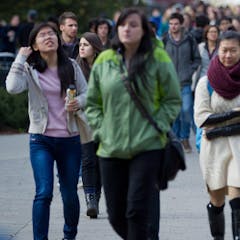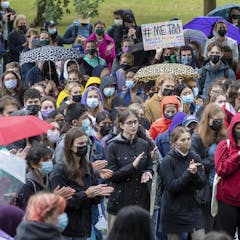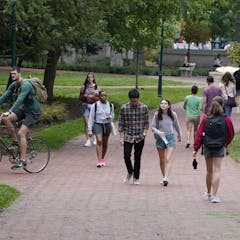
Articles on Post-secondary education
Displaying 1 - 20 of 72 articles

It’s important that universities publicly acknowledge the importance of Black-affirming community spaces and the role they play in Black student well-being and academic success.

Resources from the United Nations Educational, Scientific and Cultural Organization can help marketing programs embed sustainability concerns into marketing education.

How university campuses respond to concerns about student safety can set the stage for learning or encourage its opposite: divisiveness and censorship.

Journalism educators need to have new conversations with students that address their experiences, their worries and their understanding of what journalism is and what they want it to be.

Universities must not only invest in dedicated senior equity leader roles with specialized knowledge and expertise. They must also ensure these roles are resourced and empowered with authority.

Students should know that a key part of the value of their undergraduate degree lies in taking advantage of all the opportunities for learning that universities offer.

All students who apply to university need ‘U’ courses, but Toronto-area research reveals few students with zero Grade 12 ‘U’ courses apply for any post-secondary education at all.

Who’s responsible for the factors that led to the federal government’s recently announced cap on international students, and what are the implications for those directly affected?

Learning about Generative AI should include supporting collaborative interdisciplinary research and writing ethical prompts to help discover what it can do.

Faculty and university staff are embedding training to prevent gender-based and sexual violence into curricular goals of both arts and STEM classes.

Student residences built in recent decades prioritize privacy, yet research shows a lack of student socialization spaces negatively affects students’ academic performance and well-being.

Ontario’s changed university funding formula, which forces institutions to rely on high student tuition for niche programs, is putting some northern institutions in precarious financial situations.

Forcing universities to only serve the needs of the labour market undermines their abilities to educate students and conduct research.

Labour unrest at universities is a matter of public interest. That’s why support for local, independent media outlets to provide in-depth coverage of university strikes is so important.

To address declining humanities enrolments, these programs should ensure they offer more than critical theory for identifying and analyzing problems.

Pairing disability counsellors with post-secondary instructors to help them design classes is one way colleges and universities can improve their efforts to support students with disabilities.

Governments and universities have failed to prepare for an increase in housing demand amid planned enrolment growth in higher education and a crisis driven by treating housing as an investment.

Engineers say the current ‘iron ring’ ritual is steeped in colonial worldviews and excludes the public from understanding engineers’ ethical obligations.

Education strikes by university and public school workers are political fights about diminished respect for education as a public good and workers’ rights in an economy that perpetuates inequality.

Harmful research practices have done serious damage to Indigenous communities and created distrust. The Collaborative Indigenous Research Digital Garden is one way to repair that damage.
